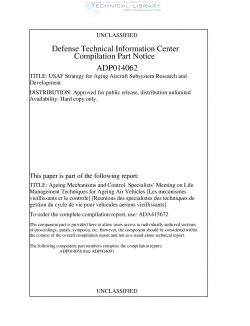DTIC-AD-P014062
- Version
- 176 Downloads
- 572.44 KB File Size
- 1 File Count
- March 5, 2017 Create Date
- March 5, 2017 Last Updated
USAF Strategy for Aging Aircraft Subsystem Research and Development

Like many other nations today, the United States A_ir Force (USAF) is retaining their existing aircraft longer than planned. It is estimated that the current average age ofaircraft in the USAF inventory today is 22 years old. By 2005, 75% of the USAF inventory will be over 20 years old. As the age of our fleet continues to rise, aircraft mission capable rates degrade and there is a potential for increased risk to safety of flight should the aircraft not be properly maintained. Maintenance data indicates that air vehicle subsystems are one of the largest contributors to aircraft downtime due to in-service failures. Fortunately aircraft typically are not lost due to the subsystem failures. However, if one is not careful, this aspect can tend to foster an attitude that we should accept these failure rates. What this approach fails to recognize is that we no longer have the budget or the number of available aircraft to support this level of maintenance. The purpose of this paper is to discuss aging aircraft concerns found in air vehicle subsystems and the approach that the USAF is using to alleviate these concerns. BACKGROUND Philosophically, the USAF aging aircraft program began in the late 1950's followihg an in-flight structural wing failure of a B-47 aircraft [l]. As a result, the USAF developed the Aircraft Structural Integrity Program (ASIP) [2]. The ASIP [3] is a disciplined engineering process that defines all of the tasks necessary to ensure the structural integrity of the air vehicle airframes. ASIP is a cradle-to-grave process and has become the basis for our aging aircraft programs. ASIP has evolved over the last 40 years into a very effective and widely accepted processthat is used extensively throughout the USM. There is an Air Force Policy Directive [4] that requires implementation of the ASIP on all the USAF aircraft programs. The process has been very effective and we have not lost a USAF airgran due to an inherent structural failure for over ten years [5].
| File | Action |
|---|---|
| DTIC-AD-P014062 USAF Strategy for Aging Aircraft Subsystem Research and Development.pdf | Download |

Comment On This Post